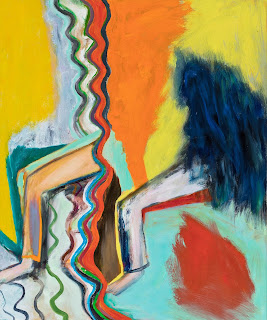David Palliser, 'Endless Conditions' (Opening Speech)
There is a scientific term – Hypnagogia – which refers to the transitional state between wakefulness and sleep. It is the time that our body is asleep, but our mind is still partially conscious. It is a state that I particularly enjoy. Amongst the more common sensory features of hypnagogia are: random speckles; lines or geometric patterns; or sometimes figurative images. They may be monochrome or richly patterned; flat or three-dimensional. Images are typically fleeting and subject to rapid change. Just when you think you have registered something it is already turning into something else. Elements are permanently in flux. They are pure – in that they have no explanatory meaning outside of themselves. They simply exist by randomly ‘coming into being’.
I always think of the hypnagogic state when I view David Palliser’s paintings. To me, they seem to operate in a similar way. Forms emerge and subside; objects are obliquely suggested, even as they meld into something else. Of course, the finished paintings are frozen at the point of completion once the artist has finalised their structures and placements and compositions to the point where they seem to him to be just right. Each one is coalesced into a pleasing resolution. But we are also afforded a glimpse into the kind of waking dream that attended the making of each picture – which is the artist and his freewheeling, stream of consciousness approach to his process. The Endless Conditions of the exhibition’s title.
I have never seen David at work on his paintings, but in a sense that work-history is evident all around us. We can peel it back like the layers of a magic onion. Making a painting is always a series of actions — forming and accumulating routes and journeys across the canvas. As we view each of David’s canvases, we can visualise the artist as he stands working on them, negotiating the perennial problems of constructing a painting. Always, there is evidence of a kind of highly rigorous improv, where decisions are made, rejected, remade, changed, accepted, reversed, diminished, enlarged, repeated, restricted, obliterated, enhanced, finalised etc. That intellectual visual journey is as thrilling for the viewer as it obviously, and necessarily, is for the painter. The results are always thrilling because the tussle is real.
We see it in action all around us in the gallery. We are aware of the artist’s decision-making at each step of the way. Will this section be brittle or soft? Will this colour combination be sweet or sour (or both)? Will this particular structure be allowed to stand, or is it to dissolve under swathes of atmospheric passages of paint? Will this element be ranged flatly on the surface or recede into the illusory staged space? Will this surface be thinly or thickly painted? Will this area be scumbled and dry, or juicy and succulent? Will this line describe the edge of a form, or will it float untethered in space, describing only its own existence? Here and there, vaguely-figurative references might emerge within the process, which may be allowed to obliquely suggest themselves amidst the abstraction. Every element in David’s painting is in flux until the very last moment when all the bells seem to chime together, signifying that the artist has won the joust.
The Swiss German artist Paul Klee wrote, in 1924,
The limitation
of the eye is its inability to see even a small surface equally sharply at all
points. The eye must ‘graze’ over the surface, grasping portion after portion,
to convey them, to the brain which collects and stores the
impressions. The eye travels along the paths the artist cuts out for it in
the work.
I like that
description of the artist cutting paths for the viewer to follow. With David’s
paintings we see that this is very much the case. But we are following the
paths that he has first had to cut for himself, through the uncharted (and
frankly, dangerous) territory of the dreaded blank canvas. Onward we go, following
in his footsteps as we, too, negotiate the trails and tracks of his process, with
the reassuring knowledge that we are in the company of a master navigator. (Not
to mention a painter at the top of his game)
And, on that note, I have great pleasure in declaring David Palliser’s exhibition, Endless Conditions, open.
_______________________________________________________________
- David Palliser's exhibition, Endless Conditions, was held at Jacob Hoerner Galleries, 1 Sutton Place, Carlton, Melbourne, 25th August - September 17th, 2022.





Comments
Post a Comment